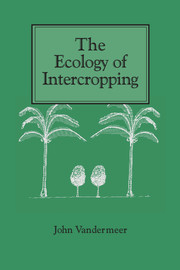Book contents
- Frontmatter
- Contents
- Preface
- 1 Introduction: intercrops and ecology
- 2 The measurement of intercrop performance
- 3 The competitive production principle
- 4 Facilitation
- 5 Mechanisms of the competitive production principle
- 6 The environments modified to produce facilitation
- 7 Special problems in intercrops involving perennials
- 8 Weeds and intercrops
- 9 Variability and intercrops
- 10 Planning intercrops – a phenomenological approach
- 11 Planning intercrops – a mechanistic approach
- 12 Critical research directions for the future
- References
- Author index
- Subject index
9 - Variability and intercrops
Published online by Cambridge University Press: 05 August 2012
- Frontmatter
- Contents
- Preface
- 1 Introduction: intercrops and ecology
- 2 The measurement of intercrop performance
- 3 The competitive production principle
- 4 Facilitation
- 5 Mechanisms of the competitive production principle
- 6 The environments modified to produce facilitation
- 7 Special problems in intercrops involving perennials
- 8 Weeds and intercrops
- 9 Variability and intercrops
- 10 Planning intercrops – a phenomenological approach
- 11 Planning intercrops – a mechanistic approach
- 12 Critical research directions for the future
- References
- Author index
- Subject index
Summary
A frequently claimed advantage of intercropping is its capability of dealing with environmental variability, implicitly equivalent to the avoidance of risk (Abalu, 1977; Francis & Sanders, 1978; Reddy & Willey, 1985; Reich & Atkins, 1970). While it is common for intercropping reviews to contain sections on variability and risk (e.g. Aiyer, 1949; Kass, 1978; Mead & Riley, 1981; Norman, 1974; Willey, 1979a; Lamberts, 1980), only rarely is the subject a central focus. Three notable exceptions are contained in the work of Rao & Willey (1980), Pearce & Edmondson (1982), and Schultz (1984). The latter work specifically treats the first two, and forms the basis of the first two sections of this chapter (measurement and evaluation, and variability under competition and facilitation).
The ecological literature on variability, and/or stability, is enormous. Useful reviews can be found in several places (e.g. Goodman, 1975; May, 1972; McNaughton, 1977; Murdoch, 1975). It had generally been held that diverse systems are more stable, or less variable. When one component either flushes or comes close to extinction, it is more likely that another component will compensate for it if a number of components are available to do so, which would be more likely in a highly diverse system than in a more monotonous system. It was, and still is, a common-sense notion, which is why May's (1972) claim of the reverse was such a surprise. All things equal, a more diverse system is expected to be less stable, not more.
- Type
- Chapter
- Information
- The Ecology of Intercropping , pp. 141 - 161Publisher: Cambridge University PressPrint publication year: 1989
- 1
- Cited by



